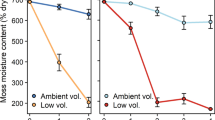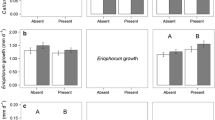Abstract
Boreal peatlands, which contain a large fraction of the world's soil organic carbon pool, may be significantly affected by changes in climate and land use, with attendant feedback to climate through changes in albedo, fluxes of energy or trace gases, and soil carbon storage. The response of peatlands to changing environmental conditions will probably be dictated in part by scale-dependent topographic heterogeneity, which is known to interact with hydrology, vegetation, nutrients, and emissions of trace gases. Because the bryophyte community can contribute the majority of aboveground production in bogs, we investigated how microscale topography affects the response of bryophyte species production and cover to warming (using overhead infrared lamps) and manipulations of water-table height within experimental mesocosms. We removed 27 intact peat monoliths (2.1-m2 surface area, 0.5–0.7 m depth) from a bog in northern Minnesota, USA, and subjected them to three warming and three water-table treatments in a fully crossed factorial design. Between 1994 and 1998, we determined annual production of the four dominant bryophyte taxa within three microtopographic zones (low, medium, and high relative to the water table). We also estimated species cover and calculated changes in topography and roughness of the bryophyte surface through time. Total production of all bryophytes, and production of the individual taxa Polytrichum strictum, Sphagnum magellanicum, and Sphagnum Section Acutifolia, were about 100% greater in low microtopographic zones than in high zones, and about 50% greater in low than in medium zones. Production of bryophytes increased along the gradient of increasing water-table heights, but in most years, total production of bryophytes was negatively correlated with height above the set water table only for the wettest water-table treatment. Although bryophyte production was unaffected by the warming treatments, the bryophyte surface flattened in proportion to the degree of warming. These results indicate that production of bryophytes is driven most strongly by the absolute and relative height of the bryophyte surface above the water table. Predicted changes in water-table height commensurate with changes in surface temperature may thus affect both production and superficial topography of bryophyte communities.
Similar content being viewed by others
Author information
Authors and Affiliations
Additional information
Electronic Publication
Rights and permissions
About this article
Cite this article
Weltzin, J.F., Harth, C., Bridgham, S.D. et al. Production and microtopography of bog bryophytes: response to warming and water-table manipulations. Oecologia 128, 557–565 (2001). https://doi.org/10.1007/s004420100691
Received:
Accepted:
Published:
Issue Date:
DOI: https://doi.org/10.1007/s004420100691




